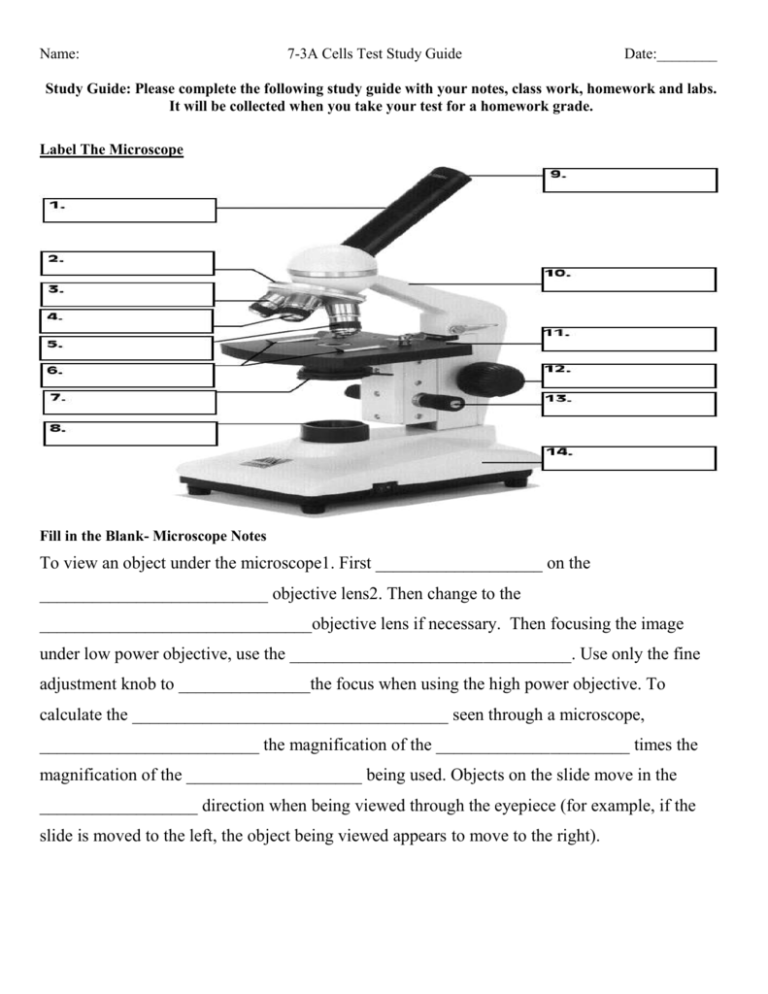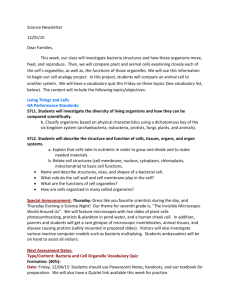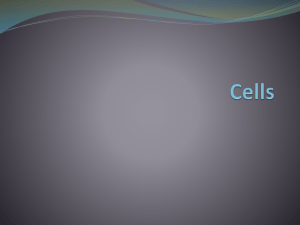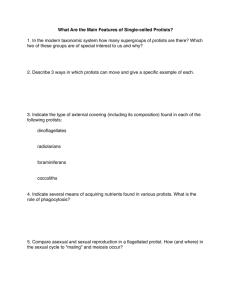Name: 7-3A Cells Test Study Guide Date:______ Study Guide
advertisement

Name: 7-3A Cells Test Study Guide Date:________ Study Guide: Please complete the following study guide with your notes, class work, homework and labs. It will be collected when you take your test for a homework grade. Label The Microscope Fill in the Blank- Microscope Notes To view an object under the microscope1. First ___________________ on the __________________________ objective lens2. Then change to the _______________________________objective lens if necessary. Then focusing the image under low power objective, use the ________________________________. Use only the fine adjustment knob to _______________the focus when using the high power objective. To calculate the ____________________________________ seen through a microscope, _________________________ the magnification of the ______________________ times the magnification of the ____________________ being used. Objects on the slide move in the __________________ direction when being viewed through the eyepiece (for example, if the slide is moved to the left, the object being viewed appears to move to the right). Name: 7-3A Cells Test Study Guide Date:________ Using the Slide Circle, draw what you see in the microscope slide to the right, then record details about the slide which maybe hard to describe in a drawing. Details: ______________________________________________________________________________ _____________________________________________________________________________________ Cells- 7-3Apart 1 Cell Structures Notes & 7-3A Part 2Animal & Plant Cell Notes It is essential for students to know that a ___________is the smallest unit of life that conducts all _________ __________________. In comparison to a cell an______________ is the smallest unit of matter. It has properties but it is not _________________. Our bodies have things that perform _____________ functions like breathing, pumping blood and filtering out toxins. These are called _________________. Each cell has major structures (_________________________) within it that perform these life functions. Many organelles are too small to be seen without the aid of a ______________________. -Cell Membrane- The thin, ________________ outer covering of a cell. It _____________what enters and leaves a cell. -Diffusion- is one way in which materials ______________. It occurs as materials are moved from an area of ________________concentration to an area of ___________________ concentration. -Osmosis- is one way in which materials move. It occurs as materials are moved from an area of higher concentration to an area of lower concentration across a _______________________. -Cytoplasm- The __________- like fluid inside of a cell made of mostly ___________________. The other ____________________are embedded in the cytoplasm. -Nucleus- Contains the genetic material (_____________) and is the _________________ center of the cell -Vacuole- Act as temporary ________________ centers. Some store water; others store ___________________ until they can be eliminated from the cell. -Chloroplasts- Are the sites where ___________________________takes place in a plant cell. They contain the _________________________used to make food -Mitochondria- Are the _______________ producing sites in the cell where. It is sometimes called the “__________________________” of the cell. -Cell Wall- Provides ___________________and _____________ for plant cells. It is made mostly of cellulose. Name: 7-3A Cells Test Study Guide Date:________ Complete the following table by writing the name of the cell part or organelle in the right hand column that matches the structure/function in the left hand column. Structure / Function Cell Part 1. Stores material within the cell. 2. Closely stacked, flattened sacs that contain chlorophyll ( in plants only) 3. Jelly- like substance in the cell that holds the organelles 4. Organelle that manages or controls all the cell functions in a cell. 5. Firm, protective structure that gives the cell its shape in plants, fungi, most bacteria and some protists. 6. Produces a usable form of energy for the cell. 7. The thin, flexible & semi permeable outer layer of the cell, composed of a phospholipid bilayer 8. Carries out respiration. List 5 Organelles that Animal Cells have. 1. 2. 3. 4. 5. For the below Animal Cell, label the five organelles you listed above. . List 7 organelles that Plant Cells have 1. 2. 3. 4. 5. 6. 7. For the plant cell below, label the 7 organelles you listed above. Name: 7-3A Cells Test Study Guide Date:________ 7-3A Part 3- Bacteria, Protist & Virus Notes It is essential for students to know bacteria by their ____________. It is essential for students to know protists (euglena, paramecium, amoeba), by the way they ________________and ____________________________. Bacteria are organisms that are classified into the ____________________ Kingdom. They are _________________ -celled organisms. They are classified by their ________________shapes. Protists are organisms that are classified into the Kingdom ____________________. Although there is a lot of variety within the protists, they do share some common characteristics. Protists are __________________ one-celled organisms that live in all ________________ environments. They vary in the way they ___________________ and ____________________. Euglena are protists that move _________________themselves with long whip like structure called ____________________. These protists can have one or more flagella that help them __________________. The euglena is unique in that it has characteristics of both a _________________ and an _______________, it contains chloroplasts that _________________________ and also can _______________ other organisms as well. Parameciums are protists that move by beating tiny ______________ structures called ____________. The cilia act as tiny oars that allow the protist to _________________ through its___________ environment. The cilia also move and help to ____________________ food directing in toward a ___________ that functions like a ________________. Amoebas are protists that move by extending their bodies forward and then pulling the rest of their bodies forward as well. The ______________________ structures that they project forward are called ________________ (false foot). The pseudopods are also used to __________ food. -Viruses Viruses are________________ particles much _______________than bacteria and can only be seen with a very powerful _______________. In isolation, viruses show none of the expected signs of _____________. They do not respond to _______________, they do not __________________; they do not do any of the things we normally associate with _____________. Therefore, they should not be considered as living organisms at all. However, viruses do show one of the most important signs of life: the ability to ____________________. Viruses are considered to be ____________________ until they infect the cells of a _____________ plant or animal and reproduce within those cells. Viruses are responsible for causing many ____________________ in living organisms (for example AIDS, colds, and flu in humans). Name: 7-3A Cells Test Study Guide Date:________ Draw, Name & Describe the shape of all three bacteria in the boxes below. Draw & Label the protists. Bacteria Name: Shape: Name: Shape: Name: Shape: Protists Name: Name: Name: How the eat: How the eat: How the eat: How they move: How they move: How they move: Use the following Table to explain the compare the characteristics of the three main Protists. PROTISTS Name of Protists How they move How they get food






